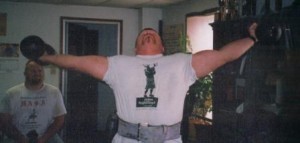Crucifix Primer
by Eric Todd

Eric Todd and his USAWA record performance in the Crucifix, with a lift of 140 pounds. (photo and caption courtesy of Al Myers)
I first found the USAWA around my second year of strongman competitions. I was gung ho to compete, and there was a hiatus between strongman meets within driving distance for me. So I stumbled upon the old USAWA website where I found the “Deanna Springs Memorial” meet held at Clark’s Gym in Columbia, MO. The meet featured the crucifix lift, which I knew was contested in some strongman meets. So I went and competed. I found out soon that there were some differences in the way the lift is contested in the USAWA from how it looks in strongman competitions. In strongman meets, you get implements of a certain weight to the crucifix position, and then you hold them there for time. Your time stops when a judge determines your position no longer meets the criteria for crucifix (i.e. Arms drop, elbows bend, etc.) In the USAWA, you pick the weight. The rules read as follows:
Two evenly loaded dumbbells or kettlebells are used for this lift. The lift begins at the lifter’s discretion. The dumbbells are taken to arms’ length overhead with the palms of the hands facing each other and dumbbells touching. The lifter must bring the feet together so the heels are together and touching. The body must be upright at the start of the lift. Once in this position, an official will give the command to start the lift. The lifter will then lower the dumbbells to the side with arms’ straight and palms up. Elbows must be fully locked. The lifter may lean back to any extent when lowering the dumbbells. The wrists do not need to be held straight. The legs must remain straight and knees locked throughout the lift. The heels must remain together and the heels and toes must not rise during the lift. Once the arms are parallel to the platform, and the dumbbells motionless, an official will give a command to end the lift. (Myers, A. (Ed.). (2014). USAWA Official Rulebook (8th ed., p. E8). Holland, Kansas: Al Myers)
Well, as it turns out, I wound up being decent at both versions. I hold several records in the discipline in the USAWA, and held the amateur national record in strongman. So, I thought I would write a brief primer on the finer details of completing the lift.
Clean the dumbbells to your shoulders. As I press them overhead, I like to turn them so that the palms are facing when they reach arm’s length. At this point, I bring my heels together. Hook one slightly behind the other to ensure they do not come apart. When the official gives the command to begin the start of the lift, begin the decent of the dumbbells SLOWLY. As you lower the dumbbells, look up and lay back as far as you can. This will keep the dumbbells parallel with the floor. Squeeze your glutes in order to give you stability whilst laying back. Try to take the strain across your pecs as best as you can to give you the most strength possible. It is up to you to: A) Know when you have reached parallel or B) Have someone tell you. This is not the job of the judge. When you near this point, slow down, and when you reach it, stop. You will only have to hold it still briefly, but it will feel like an eternity. Wait for the official’s down call. Once you hear that, you have the lift. Congrats!
As the crucifix has been both on the record book, and now as our official insignia (though I question whose likeness they used) it is a staple of all-round lifting, thus one to take pride in doing right.